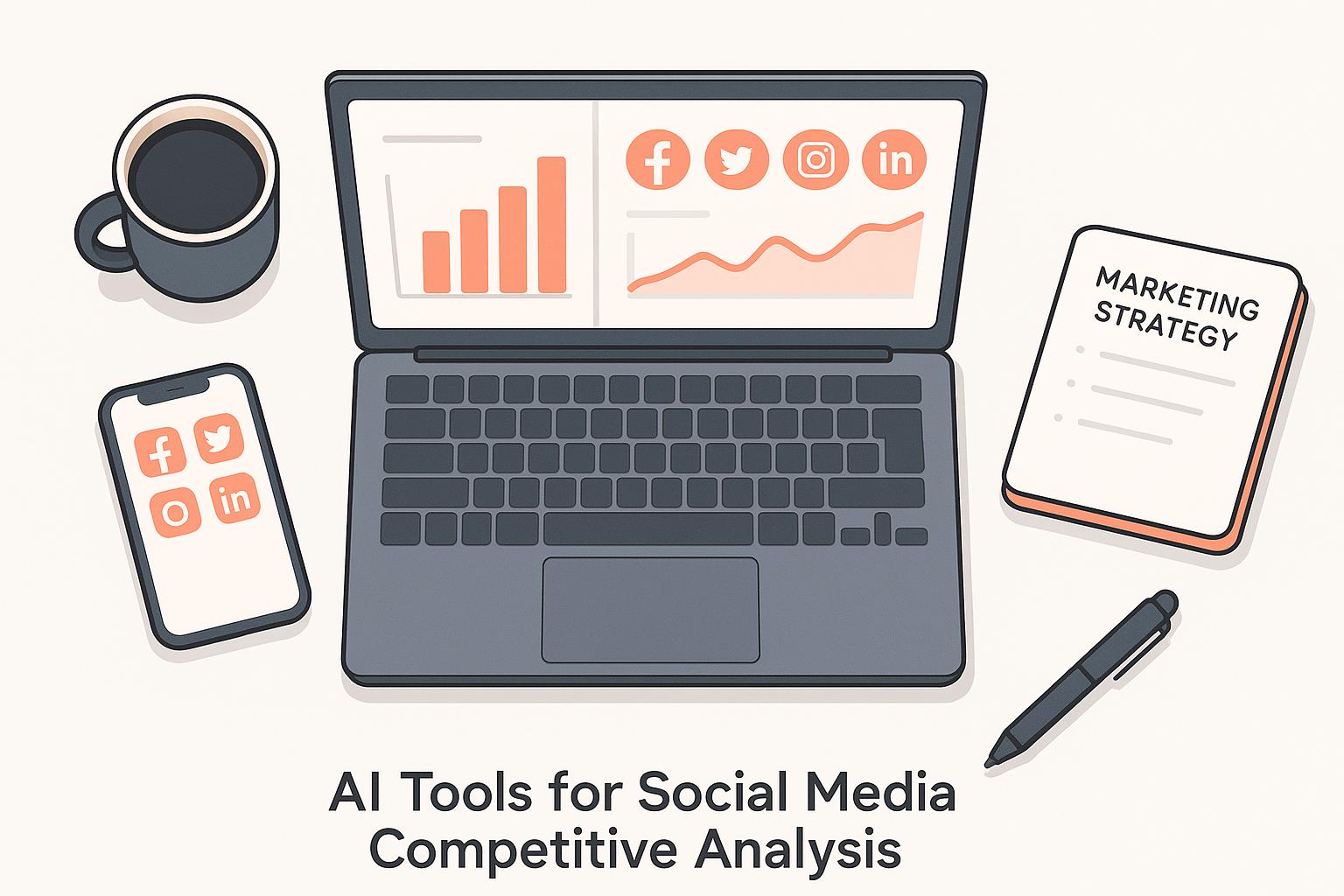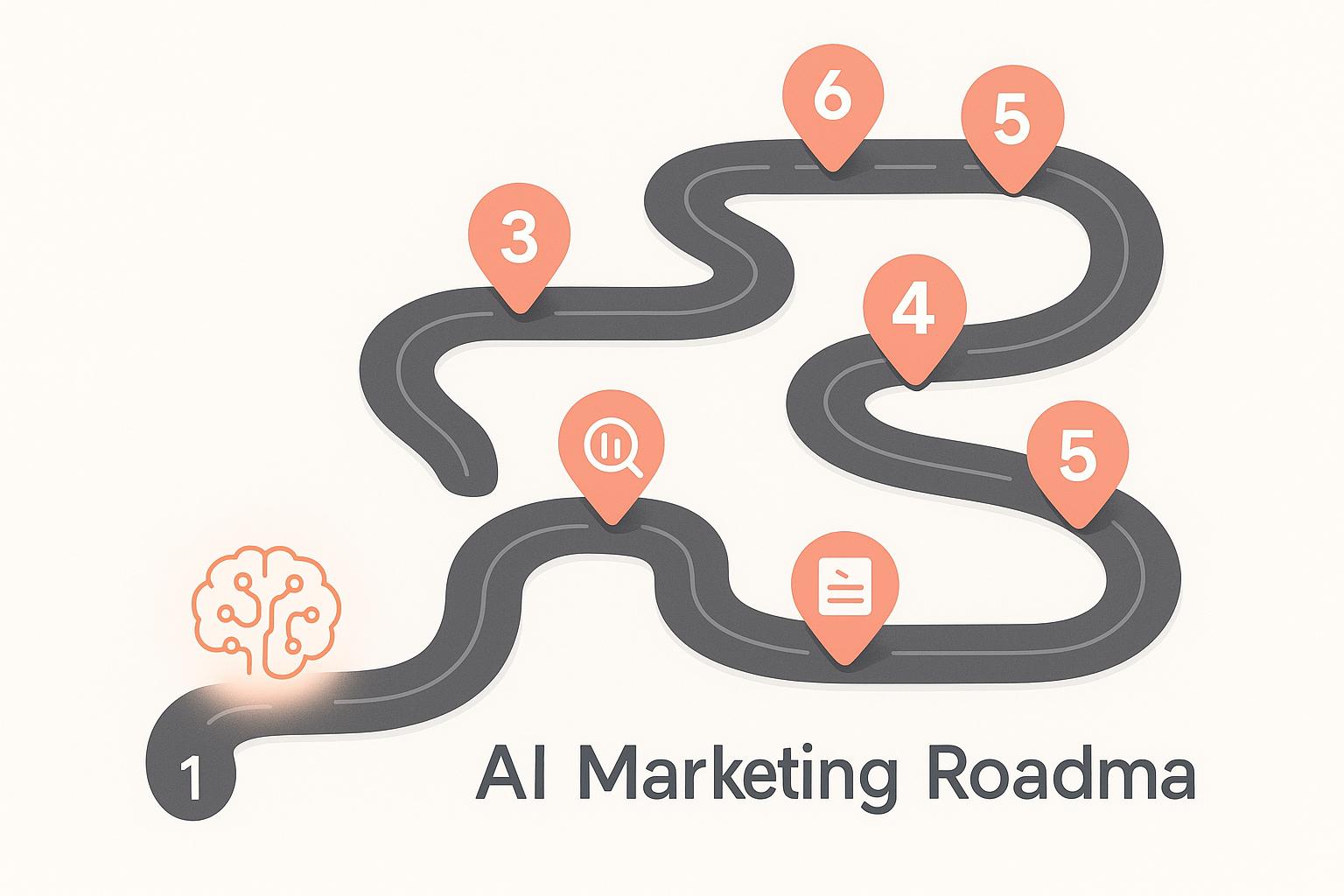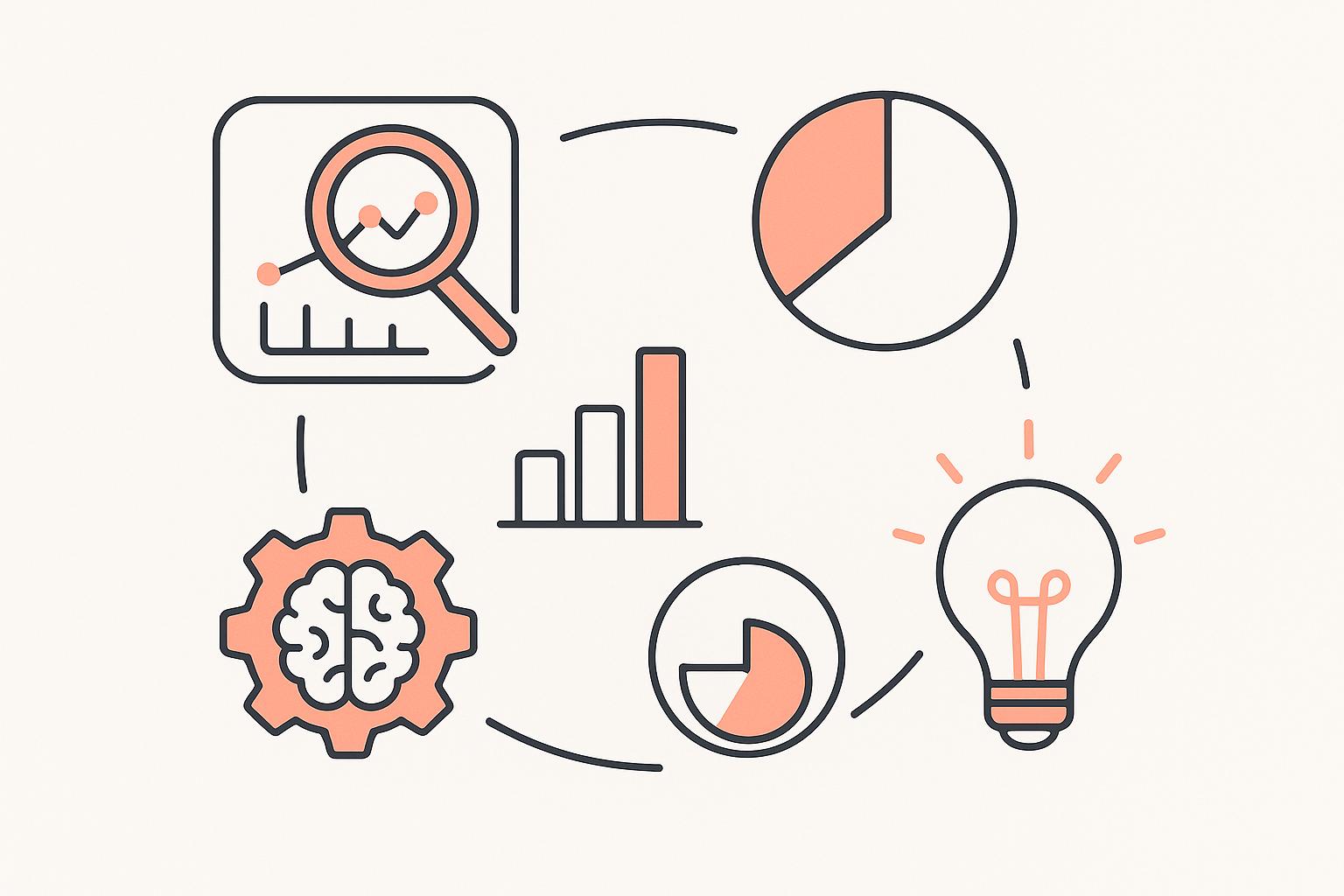AI is transforming retargeting ads by making them smarter, more precise, and efficient. Here's what you need to know:
- AI refines audience targeting: Instead of using broad demographics, AI analyzes user behavior (like time spent on pages or cart activity) to identify high-potential customers.
- Personalized ads drive results: AI customizes ad content - images, headlines, and offers - based on individual preferences, boosting engagement and conversions (e.g., a 40% increase in sales from abandoned cart retargeting).
- Automation saves time: AI automates repetitive tasks like bidding, budgeting, and ad updates, ensuring campaigns stay optimized in real time.
- Predictive analytics anticipates actions: By analyzing past data, AI predicts what users are likely to do next, helping marketers deliver the right message at the right time.
- Privacy compliance is critical: Companies must integrate privacy-first methods and comply with regulations like CCPA to build trust and avoid fines.
AI-powered retargeting isn't just about better tools - it’s about smarter strategies that maximize ROI, reduce costs, and keep your campaigns ahead of the curve.
Retargeting with AI-powered dynamic ads - Business Guide
AI-Driven Personalization in Retargeting
Gone are the days when generic ads could grab attention. Thanks to AI, retargeting has evolved from a blanket approach to a highly personalized system that tailors experiences based on individual user behavior and intent. This shift is a game-changer for modern marketers, reshaping how campaigns connect with potential customers.
"Using AI for retargeting enables faster and more personalized customer experiences, leveraging real-time interaction data. AI can instantly analyze user behavior and group users based on their intent." – CloudMellow
With 65% of organizations now using generative AI in at least one business function - up from just one-third the year before - personalized retargeting is no longer optional. It’s a necessity for staying competitive. By focusing on tailored segmentation and engagement, marketers can deliver more impactful campaigns.
Better Audience Segmentation with AI
Traditional segmentation often relies on broad categories like age, location, or general behavior. AI flips this approach on its head by diving into real-time data to identify precise user patterns and intent.
AI tools analyze a wide range of data points - everything from the pages users visit and the time they spend on them to the devices they use and the time of day they interact. This level of detail uncovers micro-segments that traditional methods often overlook.
The results speak volumes. Bruntwork used Insait's digital agents to study customer behavior across their website and chat interactions, achieving a 30% conversion rate and boosting engagement by 50%. Similarly, Leumi Bank leveraged AI for predictive analytics, identifying clients most likely to open savings accounts and achieving an impressive 81% conversion rate. Service Seeking also benefited from AI-driven segmentation, refining their customer groups in real time and achieving a 33% conversion rate with 50 job completions daily.
AI’s ability to continuously update and refine these segments ensures that targeting stays sharp and effective, adapting seamlessly to changing user behaviors.
How Personalization Affects Engagement and Conversions
Once AI nails down refined segments, the next step is delivering personalized ads that resonate. By analyzing user behavior and predicting purchase intent, AI can serve up tailored images, headlines, and calls to action that truly click with individual users.
For example, an e-commerce brand used AI-powered retargeting to address abandoned carts. By dynamically showing users their abandoned items alongside personalized offers, they boosted conversion rates by 40% and significantly reduced cart abandonment. Considering that only 2–4% of online shopping carts typically convert, this improvement is a big deal.
B2B companies are also reaping the rewards. A SaaS provider used AI to predict which visitors were most likely to sign up for free trials based on their browsing habits and content engagement. The result? A 25% increase in trial sign-ups and better-quality leads.
But personalization doesn’t stop at showing the right products. AI also adapts ads based on context, device type, and external factors, creating a seamless user experience. Midwest Bank Centre, for instance, used AI agents to deliver personalized messages to 20,000 clients, achieving an 8% conversion rate and securing $5 million in deposits. Plus, short-form personalized video ads have proven to be six times more engaging than static ads.
When precise segmentation meets tailored messaging, the result is a powerful combination that drives higher conversion rates and maximizes ad spend efficiency. AI's ability to refine and personalize ensures that marketing efforts consistently hit the mark.
AI-Powered Automation for Retargeting Campaigns
Gone are the days when marketers had to manage every aspect of retargeting campaigns manually. AI automation has stepped in to revolutionize this process, taking over repetitive tasks and delivering results that traditional methods often struggle to achieve. By handling the nitty-gritty details, AI lets marketing teams focus on strategy and creativity instead of getting bogged down in execution.
For example, AI-driven bidding can reduce acquisition costs by 20–30% in B2B campaigns by zeroing in on the most promising leads. For businesses juggling multiple campaigns across various platforms, this level of automation is becoming a necessity to stay ahead of the competition. Let’s dive into how AI simplifies and optimizes campaign management.
Automated Campaign Management with AI
AI takes over the heavy lifting in retargeting campaigns, managing tasks like bidding, budgeting, creative optimization, and scheduling. By combining data from CRM systems, website activity logs, marketing automation tools, and external intent signals, AI creates a complete picture of the customer journey and uses it to make smarter decisions.
A great example of this in action is Adobe Experience Cloud. The company integrated an AI-powered platform with its Marketo data to refine its retargeting efforts. By analyzing site behavior, CRM attributes, and campaign engagement metrics, the system identified key signals that differentiated enterprise leads from smaller accounts. Over just three months, Adobe saw a 25% increase in retargeting-driven leads qualifying as MQLs (marketing-qualified leads) while cutting the cost per MQL by about 15%.
One standout feature of this approach was the system’s ability to automatically pause underperforming ads and reallocate budgets in real time. Achieving this level of optimization manually would require constant monitoring and adjustments. AI also segments audiences by their stage in the sales funnel, tailoring ad content accordingly. For instance, a new prospect might see introductory messaging, while someone already familiar with your brand could receive a more targeted offer. This level of personalization often leads to conversion rate improvements of 10–20% for B2B marketers.
Real-time adjustments take this automation to the next level, ensuring campaigns remain responsive and effective.
Real-Time Adjustments for Better Performance
The true strength of AI automation lies in its ability to make instant changes based on live data. Unlike traditional campaigns, which might only be reviewed weekly or monthly, AI systems continuously monitor performance and tweak strategies in real time. This means ads can be dynamically adjusted to match user behavior and preferences as they evolve.
For example, AI can quickly replace underperforming creatives with better options, testing different headlines or visuals to find what resonates most. The same adaptability applies to bidding strategies, ad placements, and audience targeting, ensuring every part of a campaign operates at peak performance.
HubSpot provides a clear example of this capability. By using AI to dynamically optimize ad targeting and content, the company saw a 40% increase in click-through rates on LinkedIn Ads. Similarly, BioCatch integrated AI-driven real-time adjustments into its retargeting and sales outreach efforts, achieving a 5x increase in qualified pipeline within six months - all while maintaining its existing target-account list.
What sets AI apart is its ability to learn and improve with every interaction. Over time, the system refines its decisions, becoming smarter and more effective. This kind of continuous optimization simply isn’t feasible with manual methods, making AI an indispensable tool for running high-performing retargeting campaigns.
sbb-itb-ad96eed
Using Predictive Analytics in Retargeting
Automation can fine-tune existing campaigns, but predictive analytics takes things a step further by anticipating customer behaviors. This approach shifts retargeting strategies from being reactive to proactive, fundamentally changing how marketers plan and execute campaigns.
"Predictive analytics in marketing is a data-driven approach to campaign optimization that leverages predictive modeling–a statistical and computational technique that uses historical digital marketing datasets to make informed predictions about future outcomes." – Adjust
By diving into user behavior patterns, purchase histories, and engagement trends, predictive analytics empowers marketers to act ahead of the curve. It’s about delivering the right message at just the right moment - sometimes before customers even realize they’re looking for a solution. Let’s explore how AI sharpens this process for more precise targeting.
Predicting User Actions with AI
Predictive analytics uncovers future behaviors by analyzing large sets of customer data. It examines everything from browsing habits to product interactions, helping predict what customers are likely to do next - whether it’s making a purchase, engaging with specific content, or exploring certain product categories.
The process often begins with demographic segmentation. Here, AI evaluates customer groups to understand their unique preferences and habits. For example, if a younger audience frequently shops for trendy items, predictive tools can suggest focusing ads on those products for this segment.
AI also identifies patterns like when users are most likely to make purchases, what price points drive action, or which product categories catch their attention. This turns raw data into actionable strategies that directly enhance campaign results. By leveraging marketing software, teams can navigate complex datasets and make informed decisions about future trends, ad performance, and customer behavior.
Dynamic Strategy Changes Using Machine Learning
Building on predictive insights, machine learning (ML) adds another layer by continuously optimizing campaigns in real time. These algorithms analyze past user interactions, purchase histories, and browsing behaviors to predict what content will resonate most with each individual. The result? Hyper-personalized experiences that evolve as new data comes in.
"The power of ML in retargeting comes from its ability to process vast amounts of behavioral data and identify patterns that humans might miss. These insights can reveal optimal timing for engagement, preferred channels, and content preferences that make your retargeting more effective." – Xtend Insights
One standout application is automated bidding. ML systems can optimize for goals like cost-per-acquisition (CPA) or return on ad spend (ROAS), adjusting bids based on the likelihood of conversion. This takes the guesswork out of budget planning, ensuring every dollar is spent where it can make the biggest impact.
Another powerful tool is clustering analysis, which segments audiences by grouping users with similar behaviors. These clusters allow for tailored retargeting strategies, with the algorithm refining its approach over time based on campaign results and user feedback.
Better Attribution Modeling
Predictive analytics also transforms attribution modeling, making it easier to link every customer interaction to conversions. Traditional models often struggle to account for today’s multi-touchpoint customer journeys. Predictive tools, powered by AI and machine learning, provide a clearer picture by identifying the most impactful touchpoints along the way.
These advanced models continuously learn and adapt, delivering increasingly precise insights. For example, they can predict Customer Lifetime Value (CLV), helping businesses allocate resources for maximum long-term returns. Predictive bid management further enhances this process by optimizing ad spend in real time, focusing on conversions and their broader impact on the customer journey.
To make this work, data integration is crucial. Pulling information from CRM systems, ad platforms, and analytics tools creates a unified view of campaign performance. Advanced techniques break down data silos, revealing which touchpoints truly drive results. By incorporating CLV into attribution models, marketers can better allocate resources across the entire customer journey, adapting strategies as customer behaviors and market conditions evolve.
Privacy and Compliance in AI Retargeting
As AI continues to transform retargeting with enhanced personalization and automation, the importance of addressing privacy and compliance cannot be overstated. While AI-driven retargeting significantly boosts performance, it also raises pressing concerns about data privacy and regulatory adherence. The challenge is finding the right balance - offering tailored ads without breaching ethical or legal boundaries. For instance, in 2024, 61% of AI marketing users reported compliance challenges. Despite fines exceeding $785 million, 43% of AI systems still failed to respect user data preferences. This underscores the risks businesses face when compliance isn’t prioritized from the beginning.
Privacy-First Personalization Methods
To deliver personalized retargeting while safeguarding user privacy, companies must embed privacy measures directly into their systems. Reducing reliance on personally identifiable information (PII) and incorporating privacy protections from the start can help achieve this balance. Businesses that adopt AI-based compliance tools report 54% fewer privacy-related fines, and 73% of consumers express greater loyalty to brands that transparently explain their AI usage. These privacy-first approaches align with stringent U.S. advertising laws, ensuring both compliance and trust.
Following U.S. Advertising Regulations
Navigating U.S. advertising laws requires understanding a mix of state and federal regulations, such as the California Consumer Privacy Act (CCPA) and oversight from the Federal Trade Commission (FTC). The FTC keeps a close eye on AI, focusing on risks like surveillance, fraud, and discrimination. This means companies can’t simply deploy AI tools and assume compliance - they need to actively manage risks throughout the user’s interaction with their systems.
One critical step is conducting Data Protection Impact Assessments (DPIAs) for AI systems that handle high-risk processes. Additionally, companies should establish clear data governance policies and integrate security and privacy measures into AI development. AI systems must also offer transparency in their decision-making processes, helping users understand why specific ads are shown to them.
Failing to comply with these regulations can lead to severe penalties. For example, an Austin-based SaaS startup faced a $1.2 million fine after its AI system mishandled user data. To avoid such outcomes, businesses should collaborate with compliance officers to monitor data usage and evaluate results - not just inputs - to identify issues like unequal ad performance or excessive opt-outs. Regular audits and ongoing monitoring of GDPR compliance can help identify and address potential problems before they escalate. This proactive approach is also driving advancements in explainable AI, which we’ll explore next.
Future Trends in Privacy and AI Retargeting
Explainable AI is becoming essential for ensuring compliance and building trust with consumers. Companies that prioritize explainability not only strengthen their legal standing but also enhance customer loyalty. In fact, businesses recognized as "responsible AI adopters" have seen a 24% increase in customer retention year-over-year, proving that ethical AI practices can deliver tangible business benefits. As privacy standards evolve, organizations that invest in privacy-first systems will be better equipped to adapt to new regulatory demands.
"Technology is a useful servant but a dangerous master." - Christian Lous Lange
Conclusion and Key Takeaways
AI is reshaping retargeting by making it more personalized, automated, and predictive. These advancements have led to measurable results, such as an 18% boost in conversions while keeping costs under control. AI-powered personalization is particularly impactful, potentially reducing acquisition costs by up to 50% and increasing revenue by 5–15%. Together, these tools are transforming how businesses approach retargeting.
For example, personalized ads have been shown to increase customer purchases by 46%. Coca-Cola demonstrated this when they used AI-driven targeted advertising to grow sales by 3%, reaching $12.4 billion between April and June 2024 .
AI-driven automation is another game-changer, helping marketers reduce wasted spending and improve ROI by 10–30%. This allows teams to focus more on strategy while machine learning takes care of refining bids and targeting. Among AI-enabled sales teams, these techniques have contributed to an impressive 83% revenue growth .
Privacy-first AI practices are also becoming essential. These approaches not only ensure compliance with evolving data protection regulations but also help businesses build trust with their customers. The growing trend of privacy-focused personalization allows brands to deliver tailored ads without compromising user data.
To stay competitive, businesses should leverage curated AI tools, like those available on platforms such as AI Marketing List. These directories offer a wide range of AI marketing solutions, from advertising to PPC tools, tailored to different needs. With the AI-powered marketing industry projected to surpass $107.5 billion by 2028, having access to these tools is especially critical for solopreneurs, bootstrapped founders, and marketers working with limited budgets.
FAQs
How does AI help improve retargeting ads while ensuring privacy compliance?
AI plays a key role in improving retargeting ad performance by analyzing data responsibly, all while complying with strict privacy laws like GDPR and HIPAA. It ensures that advertisers handle data transparently and prioritize user consent, making it easier to stay within legal boundaries.
Moreover, AI tools are adept at spotting and flagging questionable practices, such as using personal data without proper authorization. By leveraging anonymized data and following ethical guidelines, businesses can create personalized and effective ads without stepping over privacy lines.
How does AI improve the performance of retargeting ad campaigns?
AI takes retargeting ad campaigns to the next level by enabling precise audience segmentation, customized ad delivery, and automated optimization. It processes massive datasets in no time, uncovers patterns, and predicts user behavior, helping businesses connect with the right audience at the perfect moment with ads that truly matter.
With AI-driven insights, companies can craft ad experiences that align with individual preferences, boosting engagement and driving better returns. Plus, automation keeps campaigns running smoothly, cutting down on manual effort while ensuring top-notch performance.
How can businesses use AI automation to improve their retargeting ad campaigns?
AI automation transforms retargeting ad campaigns by introducing smarter personalization, accurate audience segmentation, and continuous refinement. By studying user behavior and preferences, AI crafts ads that resonate more deeply, driving higher engagement and improving conversion rates.
Thanks to real-time data analysis, AI-powered tools can instantly tweak ad creatives, targeting strategies, and delivery frequency to optimize return on ad spend (ROAS). This not only cuts down on manual work but also ensures campaigns stay in sync with user activity, helping businesses grow steadily while saving valuable time.


